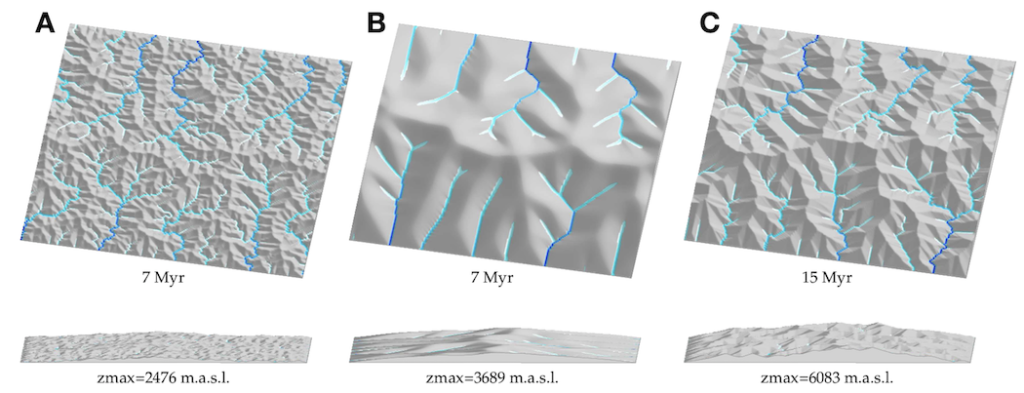
For beginners
Like any science, geomorphology has its own jargon. Whether it is misused, or
imprecise, it becomes a source of great confusion for students and researchers alike.
It can also lead to false but intuitive conceptual models. An emblematic
example is the relationship between topography and rain. In the minds of
many, more rain means more erosion and therefore a relief with deeply cut
rivers, forming a very jagged landscape. For experts, the paper of Whipple
et al. (1999) is worth reading. But before that, for beginners it is interesting to
deconstruct intuitive but false associations. LEMs help in this deconstruction.
Starting a geomorphology class with the following test has always proved to be
very useful. Ask students to explain why these three topographies A, B
and C are different. Make three columns, A, B, C, and record the students’
proposals. In general, the explanations that emerge include ”more rain”, ”harder
rocks”, ”more uplift”, ”more time”, ”more erosion”. The students justify these
explanations by ”more erosion”, ”more rivers”, ”more digging”, ”rougher relief”
etc...
From the explanations given by the students, it is interesting to define precisely the notions of ”erosion” (total erosion in relation to a reference surface), ”erosion rate”, ”drainage density”, ”relief” and ”response time”. Then it is interesting to show that the erosion rate (m/yr) is the same in cases A, B and C. Indeed, since the topography has reached a state of dynamic equilibrium in these three cases, the rate of erosion balances at all points the rate of tectonic uplift (ϵ = U). So although the mountains look different, they are eroding at the same rate. Next, it is interesting to realize that the rate of precipitation is different in A (reference) and C (P∕2), yet both mountains are eroding at the same rate. It is the slope and drainage density that adapt to compensate for a lower rainfall in case C. On the other hand, even if B looks less ”angular”, it does not mean that it erodes less quickly. It’s just that in this case, the rocks on the hillslopes erode more easily (κx100) by gravity processes (soil-creep, etc. known as diffusive processes).
References